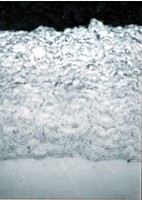

Metal products used for creation of steel constructions, machine and device construction are utilized in highly corrosive environment, where they can be destroyed by way of electrochemical corrosion. One of the basic methods related with securing steel against corrosion is to lay protective coatings, for example with the metal spraying method. The most common metal sheet used for steel products is the zinc coating. Since this type of coating is electronegative in contact with steel products, it fulfils two functions, namely it separates the protected base from the corrosive environment, and also enables to protect (electrochemical protection) the foundation in case layer discontinuity should occur (f. ex. as a result of mechanical damage).
Production of zinc coatings with metal spraying consists in fusing coating material under the hot gas stream (flame, plasma and detonation pistols) and lifting melted particles by the gas stream towards the coated surface. The obtained coating develops an adhesive or adhesive/diffusive bond with the foundation.
Metal sprayed coating thickness depends on the parameters of the technological process, the so-called thermal force, mass expenditure of the pistol and number of transitions - ranges from 90 to 300 micrometers, which gives mass expenditure equalling from 600 to 1800 g/m2. The structure of these coatings constitutes a dense mass of flattened particles. Thickness (size) of the sprayed particles, metal oxidation level and particles deformation depends on the parameters of the process, such as f. ex. in case of flame pistols the oxygen, acetylene and air pressure - distance and spraying angle. Depending on the type of corrosive environment the following annual corrosion losses for zinc coatings are accepted:
The above mentioned data enable to determine the durability of zinc coatings in the highly aggressive environment (industrial atmosphere) and so the durability for 120 micron thick coatings equals about 10 years and for 250 micron thick coatings lasts up to 25 years. These indices do not include aggressive factors existing in the particular case. Hence, in order to prolong the protective period, additional protection in the form of painted coatings is used. Protective period in case of such protection is about four times longer than the period for the sole painted coating. This method is commonly called "duplex" and it significantly increases the corrosion resistance of metallic coatings, including zinc ones. Additional painted coating separates the metal coating from the corrosive environment. This is connected with additional costs related with creating coatings, however, these costs are compensated their longer life and prolonged periods without the necessity to renew coatings. As painted coatings create an adhesive bond with the foundation, which requires their good adherence with the zinc coating. Naturally, the thermal sprayed coatings ensure the proper adhesion of painted coatings. Metal spraying technology enables to regenerate worn parts of various devices, as well as to manage production shortages, restoring their applied features. As a result of using the above mentioned technology coatings of various features may be obtained on products created from various materials, which causes the reduction of production costs, raise in quality and durability of the performed elements.



PLASMA NOWA company possesses high quality equipment for performing the above mentioned works: screw compressors, metal spraying pistols (flame, bow pistols) and varnish pistols. Within the realised works PLASMA NOWA company realised protection and renovation of numerous steel constructions, among others: (see: realisation gallery):